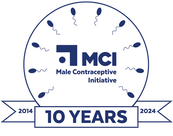|
Dr. Patricia S. Cuasnicu is a Senior Scientific Researcher from the National Research Council (CONICET) at Argentina’s Instituto de Biologia y Medicina Experimental (IBYME-CONICET) in Buenos Aires. MCI awarded Dr. Cuasnicu with a $150,000 seed grant in 2018 to aid in the continuation of her work. What is your connection to contraception?I have been connected mainly to the area of “male contraception” since 1984, when I began my post-doctoral experience working as an NIH fellow at Cornell Medical Center, New York Hospital under the direction of Dr. J. Michael Bedford. As Dr Bedford had been really interested in analyzing the potential use of epididymal proteins for male contraception development, we presented a post-doctoral research plan aimed to study the contraceptive potential of purified CRISP1, an epididymal protein identified by our laboratory in 1976 and the first member of the CRISP (Cysteine Rich Secretory Protein) family. Upon my return to Argentina in 1986, I continued working in the area of male contraception. In fact, due to my involvement in the field, I was invited in 1989 to be a member of the Task Force Committee on Male Methods of Contraception of the World Health Organization (WHO) founded by J. M Bedford and colleagues in 1974. I worked as WHO consultant for 15 years participating not only in the evaluations of numerous projects from all over the world but also giving presentations in many countries with high populations such as Thailand, Indonesia, India, China, Zimbabwe, and more. The contact with people in these countries together with my active work at WHO completely convinced me about the need of male involvement in family planning and, thus, about the need for new male options. While being part of the WHO committee, I was invited to be part of the Technical and Advisory Committee (TAC) of CONRAD (Contraception Research and Development) aimed to develop both male and female contraceptive methods and, again, I worked with this agency for many more than 12 years. I have been working in the field for almost 35 years and I am completely convinced that the development of more contraceptive options is crucial for avoiding the high number of women and child deaths all over the world. In addition, whereas a female method can avoid the pregnancy of the woman using that contraceptive, a male method can prevent the pregnancy of all the women interacting with the man using the contraceptive method having, therefore, a higher impact than female methods. How has the sector changed from the time you began working in it to date?What I have seen during all these years, is a clear decrease in interest in male contraceptive development from organizations as well as from companies/industry. I believe this lack of interest is due to the numerous difficulties encountered in male contraceptive development related to both a) the intrinsic properties of male physiology (i.e., how to get a good method without interfering with male libido or without generating too many side effects which are tolerated by women but not by men) and b) the many years of financial investment without getting an over-the-counter male method. In this sense, MCI becomes an important new hope after so many years of lacking support for this field. What do you think are the biggest challenges affecting contraception, generally, and male contraception, specifically?In my opinion, one of the biggest challenges affecting contraception in general is education, meaning to inform women and men about the different contraceptive options already available, especially young people at schools. Regarding male contraception specifically, I think that one of the challenges is to get a method that does not interfere with men’s libido, that does not produce visible side effects such as testicular shrinkage or a decrease in ejaculate volume, and that does not produce more general side effects (e.g.,acne, increase in cholesterol, headaches, etc.) which many men have little tolerance for. I think that most of the side effects of a female contraceptive method are tolerated by women because without it they could get pregnant, which is clearly a worse consequence in the final balance. However, in the case of men, who are relatively free from the direct consequences of pregnancy, side effects become a more significant problem to face. Due to this, they have more and higher demands than women in this regard. Have these challenges and opportunities evolved over time? If so, how?I think that the society has changed a lot over the past 20 years all over the world. Jobs and activities that used to be just for women or just for men are now shared by both. Contraception will not be different in that regard, especially due to a great change in women’s rights. What are your hopes for the near and far future of male contraception?I am sure that in the near future, male methods will become completely acceptable by all of society and that we just need to provide more options for men to allow them to be actively engaged in family planning. Also, I envisage “unisex” methods that can be used by men and women based on a specific blockage of sperm functionality in either male or female reproductive tracts. Also, we can think of a pericoital contraceptive method that can be used just before sexual intercourse. Finally, and ideally, we could think in a contraceptive method that prevents both fertility and infectious diseases simultaneously. What will it take for these to become reality?As is already well known, we need more funding in the area of male contraception to bring more researchers involved in the field and to increase the chances of getting a good, reliable, acceptable, and affordable male method. However, even when we succeed in developing new male methods, we still need more sexual education to explain to people, especially young people, the need for using contraceptive methods, as well as how to use them. Having a new method is a necessary condition but that alone is not enough: we need a society that understands the need for using contraception, including the methods already available. Are there barriers to prevent these from coming to fruition?I think that one of the great barriers that prevent these from coming to fruition is the lack of awareness by people about the key role of contraception for human health and, of course, the lack of commitment by governments all over the world, which is ultimately reflected in the low public funding in the area. Contraception is not as profitable as Viagra or cancer drugs, and because of this, companies and industries are not as interested in investing in new contraceptive methods. Commitment and funding are therefore the main barriers. Please share any anecdotes from your experiences working in the sector.In 2005, I was invited by the American Society of Andrology (ASA) to give a talk in Seoul, Korea, about Women in Science in developing countries while an american researcher would be giving a talk about women in developed countries. It took me a lot of time to prepare that talk of 25 min. I read a lot of articles and became aware of many issues like the glass ceiling for women, the leaking pipe (all the women that give up and leave their careers), the pyramid (many women for common jobs at the base of the pyramid and only few men for the best jobs in the top of it), etc.
Additionally, I also became aware of many aspects about myself that I had never paid attention to before. For example, that I had made an NIH postdoc in USA in 1984, accompanied by my husband, something completely unusual in our country where women used to accompany men. Also, that I had became one of the very few women of the WHO committee, that I had travelled around the world leaving my little children with my husband, another unusual thing for women, and, finally, that I had been working all those years in a very special area such as male contraception. I had never realized that I had been fighting for women’s rights in each of these actions and decisions and that my work in male contraception has been part of this fight for women’s rights. Also, since I began to work in male contraception 35 years ago, I realized how interested people are in this field. It is very common that when I start to talk about my work in any social meeting, people gather around me and begin to ask a lot of questions and make comments. Of course, I always receive a lot of support for my work from women who are willing to have a male method now or even in few years to avoid their daughters using contraceptive methods for more than 30 years as it occurs now. Men are very curious about the field but clearly express their fears about side effects and the possibility of losing potency or virility. In any case, I found that male contraception is a fascinating topic for everybody and to discuss it has always been a wonderful experience and even a social success.
0 Comments
Your comment will be posted after it is approved.
Leave a Reply. |
Categories
All
Archives
June 2024
|
|
|
Donate to Male Contraceptive InitiativeYour generous donation makes a difference!
|
© Male Contraceptive Initiative. All rights reserved.


 RSS Feed
RSS Feed
